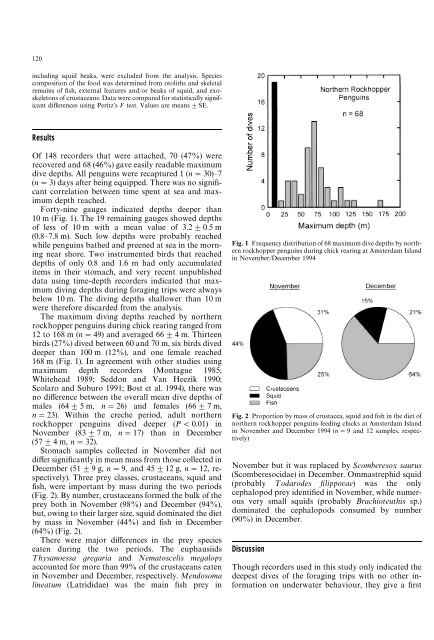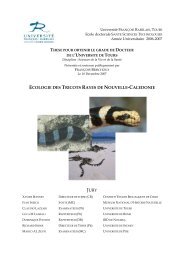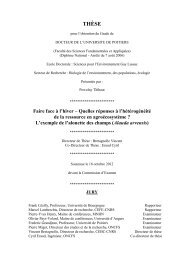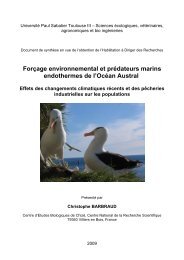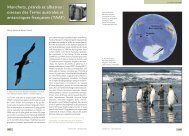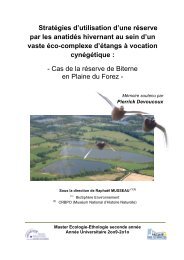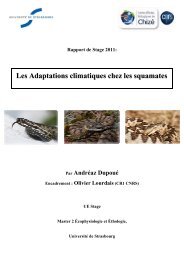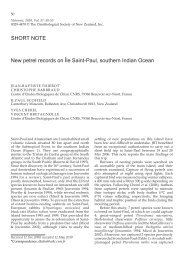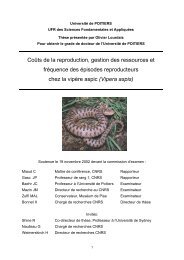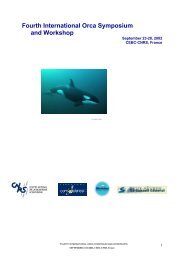Maximum diving depths of northern rockhopper penguins ... - CEBC
Maximum diving depths of northern rockhopper penguins ... - CEBC
Maximum diving depths of northern rockhopper penguins ... - CEBC
You also want an ePaper? Increase the reach of your titles
YUMPU automatically turns print PDFs into web optimized ePapers that Google loves.
120<br />
including squid beaks, were excluded from the analysis. Species<br />
composition <strong>of</strong> the food was determined from otoliths and skeletal<br />
remains <strong>of</strong> fish, external features and/or beaks <strong>of</strong> squid, and exoskeletons<br />
<strong>of</strong> crustaceans. Data were compared for statistically significant<br />
differences using Peritz’s F test. Values are means$SE.<br />
Results<br />
Of 148 recorders that were attached, 70 (47%) were<br />
recovered and 68 (46%) gave easily readable maximum<br />
dive <strong>depths</strong>. All <strong>penguins</strong> were recaptured 1 (n"30)—7<br />
(n"3) days after being equipped. There was no significant<br />
correlation between time spent at sea and maximum<br />
depth reached.<br />
Forty-nine gauges indicated <strong>depths</strong> deeper than<br />
10 m (Fig. 1). The 19 remaining gauges showed <strong>depths</strong><br />
<strong>of</strong> less <strong>of</strong> 10 m with a mean value <strong>of</strong> 3.2$0.5 m<br />
(0.8—7.8 m). Such low <strong>depths</strong> were probably reached<br />
while <strong>penguins</strong> bathed and preened at sea in the morning<br />
near shore. Two instrumented birds that reached<br />
<strong>depths</strong> <strong>of</strong> only 0.8 and 1.6 m had only accumulated<br />
items in their stomach, and very recent unpublished<br />
data using time-depth recorders indicated that maximum<br />
<strong>diving</strong> <strong>depths</strong> during foraging trips were always<br />
below 10 m. The <strong>diving</strong> <strong>depths</strong> shallower than 10 m<br />
were therefore discarded from the analysis.<br />
The maximum <strong>diving</strong> <strong>depths</strong> reached by <strong>northern</strong><br />
<strong>rockhopper</strong> <strong>penguins</strong> during chick rearing ranged from<br />
12 to 168 m (n"49) and averaged 66$4 m. Thirteen<br />
birds (27%) dived between 60 and 70 m, six birds dived<br />
deeper than 100 m (12%), and one female reached<br />
168 m (Fig. 1). In agreement with other studies using<br />
maximum depth recorders (Montague 1985;<br />
Whitehead 1989; Seddon and Van Heezik 1990;<br />
Scolaro and Suburo 1991; Bost et al. 1994), there was<br />
no difference between the overall mean dive <strong>depths</strong> <strong>of</strong><br />
males (64$5m, n"26) and females (66$7m,<br />
n"23). Within the creche period, adult <strong>northern</strong><br />
<strong>rockhopper</strong> <strong>penguins</strong> dived deeper (P(0.01) in<br />
November (83$7m, n"17) than in December<br />
(57$4m,n"32).<br />
Stomach samples collected in November did not<br />
differ significantly in mean mass from those collected in<br />
December (51$9g, n"9, and 45$12 g, n"12, respectively).<br />
Three prey classes, crustaceans, squid and<br />
fish, were important by mass during the two periods<br />
(Fig. 2). By number, crustaceans formed the bulk <strong>of</strong> the<br />
prey both in November (98%) and December (94%),<br />
but, owing to their larger size, squid dominated the diet<br />
by mass in November (44%) and fish in December<br />
(64%) (Fig. 2).<br />
There were major differences in the prey species<br />
eaten during the two periods. The euphausiids<br />
¹hysanoessa gregaria and Nematoscelis megalops<br />
accounted for more than 99% <strong>of</strong> the crustaceans eaten<br />
in November and December, respectively. Mendosoma<br />
lineatum (Latrididae) was the main fish prey in<br />
Fig. 1 Frequency distribution <strong>of</strong> 68 maximum dive <strong>depths</strong> by <strong>northern</strong><br />
<strong>rockhopper</strong> <strong>penguins</strong> during chick rearing at Amsterdam Island<br />
in November/December 1994<br />
Fig. 2 Proportion by mass <strong>of</strong> crustacea, squid and fish in the diet <strong>of</strong><br />
<strong>northern</strong> <strong>rockhopper</strong> <strong>penguins</strong> feeding chicks at Amsterdam Island<br />
in November and December 1994 (n"9 and 12 samples, respectively)<br />
November but it was replaced by Scomberesox saurus<br />
(Scomberesocidae) in December. Ommastrephid squid<br />
(probably ¹odarodes filippovae) was the only<br />
cephalopod prey identified in November, while numerous<br />
very small squids (probably Brachioteuthis sp.)<br />
dominated the cephalopods consumed by number<br />
(90%) in December.<br />
Discussion<br />
Though recorders used in this study only indicated the<br />
deepest dives <strong>of</strong> the foraging trips with no other information<br />
on underwater behaviour, they give a first


